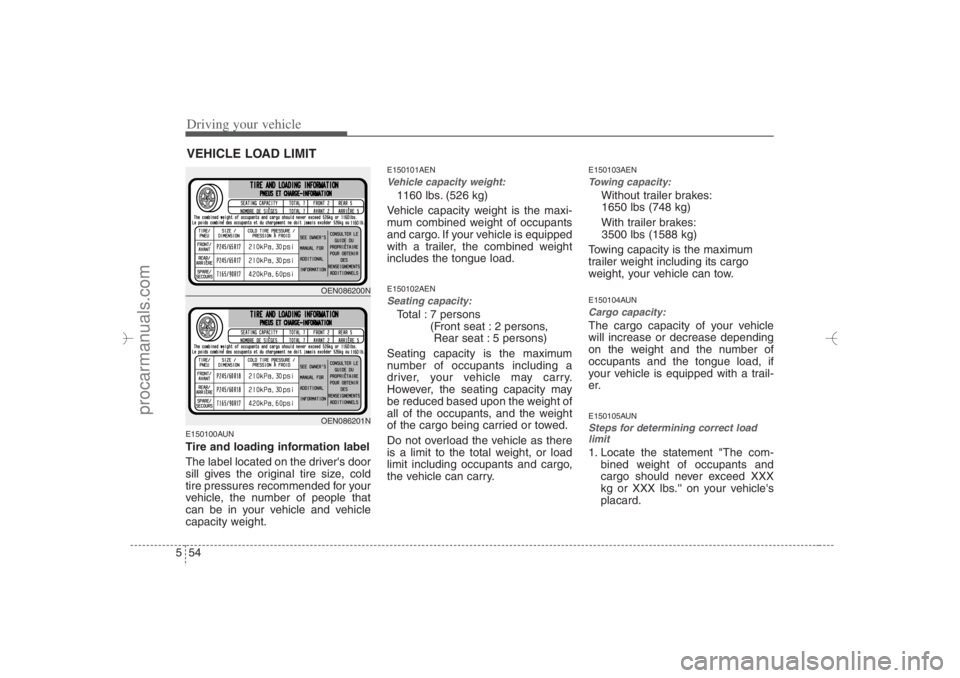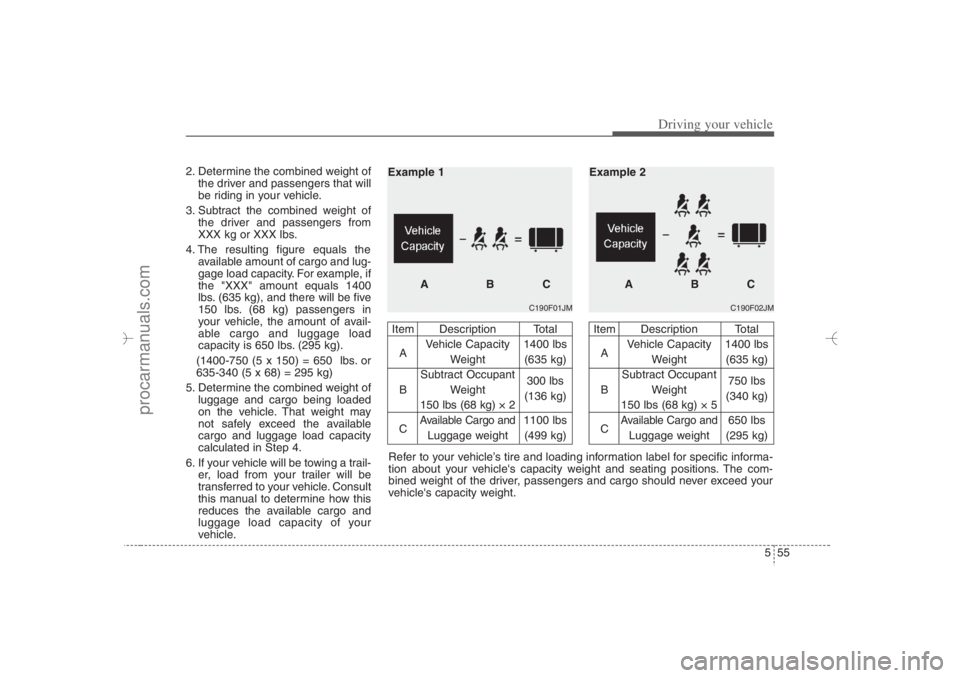2007 HYUNDAI VERACRUZ towing capacity
[x] Cancel search: towing capacityPage 317 of 441

Driving your vehicle46 5E140000AENIf you are considering towing with with
your car, you should first check with your
state’s Department of Motor Vehicles to
determine their legal requirements.
Since laws vary from state to state the
requirements for towing trailers, cars, or
other types of vehicles or apparatus may
differ. Ask an authorized HYUNDAI deal-
er for further details before towing.
Your vehicle can tow a trailer. To identify
what the vehicle trailering capacity is for
your vehicle, you should read the infor-
mation in “Weight of the trailer” that
appears later in this section.Remember that trailering is different than
just driving your vehicle by itself.
Trailering means changes in handling,
durability, and fuel economy. Successful,
safe trailering requires correct equip-
ment, and it has to be used properly.
This section contains many time-tested,
important trailering tips and safety rules.
Many of these are important for your
safety and that of your passengers.
Please read this section carefully before
you pull a trailer.
Load-pulling components such as the
engine, transaxle, wheel assemblies, and
tires are forced to work harder against
the load of the added weight. The engine
is required to operate at relatively higher
speeds and under greater loads. This
additional burden generates extra heat.
The trailer also adds considerably to
wind resistance, increasing the pulling
requirements.TRAILER TOWING
WARNING
- Towing a trail-
er
If you don't use the correct equip-
ment and drive improperly, you can
lose control when you pull a trailer.
For example, if the trailer is too
heavy, the brakes may not work
well - or even at all. You and your
passengers could be seriously or
fatally injured. Pull a trailer only if
you have followed all the steps in
this section.
WARNING
- Weight limits
Before towing, make sure the total
trailer weight, gross combination
weight, gross vehicle weight, gross
axle weight and trailer tongue load
are all within the limits.
CAUTION
Pulling a trailer improperly can
damage your vehicle and result in
costly repairs not covered by your
warranty. To pull a trailer correctly,
follow the advice in this section.
EN hma 5.qxd 11/28/2006 3:01 PM Page 46
procarmanuals.com
Page 325 of 441

Driving your vehicle54 5E150100AUNTire and loading information label
The label located on the driver's door
sill gives the original tire size, cold
tire pressures recommended for your
vehicle, the number of people that
can be in your vehicle and vehicle
capacity weight.
E150101AENVehicle capacity weight:1160 lbs. (526 kg)
Vehicle capacity weight is the maxi-
mum combined weight of occupants
and cargo. If your vehicle is equipped
with a trailer, the combined weight
includes the tongue load.E150102AENSeating capacity:Total : 7 persons
(Front seat : 2 persons,
Rear seat : 5 persons)
Seating capacity is the maximum
number of occupants including a
driver, your vehicle may carry.
However, the seating capacity may
be reduced based upon the weight of
all of the occupants, and the weight
of the cargo being carried or towed.
Do not overload the vehicle as there
is a limit to the total weight, or load
limit including occupants and cargo,
the vehicle can carry.
E150103AENTowing capacity:
Without trailer brakes:
1650 lbs (748 kg)
With trailer brakes:
3500 lbs (1588 kg)
Towing capacity is the maximum
trailer weight including its cargo
weight, your vehicle can tow.
E150104AUNCargo capacity:The cargo capacity of your vehicle
will increase or decrease depending
on the weight and the number of
occupants and the tongue load, if
your vehicle is equipped with a trail-
er.E150105AUNSteps for determining correct load
limit1. Locate the statement "The com-
bined weight of occupants and
cargo should never exceed XXX
kg or XXX lbs.'' on your vehicle's
placard.
VEHICLE LOAD LIMIT
OEN086200NOEN086201N
EN hma 5.qxd 11/28/2006 3:02 PM Page 54
procarmanuals.com
Page 326 of 441

555
Driving your vehicle
2. Determine the combined weight of
the driver and passengers that will
be riding in your vehicle.
3. Subtract the combined weight of
the driver and passengers from
XXX kg or XXX lbs.
4. The resulting figure equals the
available amount of cargo and lug-
gage load capacity. For example, if
the "XXX" amount equals 1400
lbs. (635 kg), and there will be five
150 lbs. (68 kg) passengers in
your vehicle, the amount of avail-
able cargo and luggage load
capacity is 650 lbs. (295 kg).
(1400-750 (5 x 150) = 650 lbs. or
635-340 (5 x 68) = 295 kg)
5. Determine the combined weight of
luggage and cargo being loaded
on the vehicle. That weight may
not safely exceed the available
cargo and luggage load capacity
calculated in Step 4.
6. If your vehicle will be towing a trail-
er, load from your trailer will be
transferred to your vehicle. Consult
this manual to determine how this
reduces the available cargo and
luggage load capacity of your
vehicle.Refer to your vehicle’s tire and loading information label for specific informa-
tion about your vehicle's capacity weight and seating positions. The com-
bined weight of the driver, passengers and cargo should never exceed your
vehicle's capacity weight.
C190F01JM
Item Description Total
AVehicle Capacity 1400 lbs
Weight (635 kg)
Subtract Occupant
B Weight 300 lbs
150 lbs (68 kg) × 2(136 kg)
C
Available Cargo and
1100 lbs
Luggage weight (499 kg)
Example 1
ABC
C190F02JM
Item Description Total
AVehicle Capacity 1400 lbs
Weight (635 kg)
Subtract Occupant
B Weight 750 lbs
150 lbs (68 kg) × 5(340 kg)
C
Available Cargo and
650 lbs
Luggage weight (295 kg)
ABC Example 2
EN hma 5.qxd 11/28/2006 3:02 PM Page 55
procarmanuals.com
Page 438 of 441

Index6I
Luggage box ······························································4-111
Sunglass holder ··························································4-110
Sunroof···········································································4-34
Tailgate ··········································································4-19
Emergency tailgate safety release ·······························4-20
Power ON/OFF button ················································4-23
Power tailgate ······························································4-21
Theft-alarm system ························································4-13
Tires pressure monitoring system (TPMS)······················6-7
Changing a tire with TPMS·········································6-10
Low tire pressure position telltale ·································6-8
Low tire pressure telltale ···············································6-8
TPMS (Tire pressure monitoring system)
malfunction indicator ·················································6-9
Tire specification and pressure label ·······························8-2
Tires and wheels ·····················································7-30, 9-3
All season tires ····························································7-41
Checking tire inflation pressure ··································7-31
Compact spare tire replacement ··································7-35
Radial-ply tires ····························································7-42
Recommended cold tire inflation pressures ················7-30
Snow tires ····································································7-41
Summer tires································································7-41
Tire care ·······································································7-30
Tire chains ···································································7-42
Tire maintenance ·························································7-35Tire replacement ··························································7-34
Tire rotation ·································································7-32
Tire sidewall labeling ··················································7-36
Tire terminology and definitions ·································7-39
Tire traction ·································································7-35
Wheel alignment and tire balance ·······························7-33
Wheel replacement ······················································7-35
Towing ···········································································6-21
Emergency towing ·······················································6-23
Removable towing hook (rear)····································6-22
Tie-down hook (for flatbed towing) ····························6-25
Trailer towing ································································5-46
Hitches ·········································································5-47
Safety chains································································5-47
Trailer brakes ·······························································5-47
Trailer connector··························································5-53
Weight of the trailer (tongue) ······································5-52
Vehicle break-in process ··················································1-5
Vehicle certification label ················································8-2
Vehicle data collection and event data recorders ············1-6
Vehicle identification number (VIN) ·······························8-2
Vehicle load limit ···························································5-54
Cargo capacity ·····························································5-54
Certification label ························································5-56
Seating capacity ···························································5-54
Tire and loading information label ······························5-54T
V
EN hma Index.qxd 11/28/2006 1:23 PM Page 6
procarmanuals.com
Page 439 of 441

I7
Index
Towing capacity···························································5-54
Vehicle capacity weight ···············································5-54
Vehicle weight ·······························································5-58
Base curb weight ·························································5-58
Cargo weight ·······························································5-58
GAW (Gross axle weight) ···········································5-58
GAWR (Gross axle weight rating) ······························5-58
GVW (Gross vehicle weight) ······································5-58
GVWR (Gross vehicle weight rating) ·························5-58
Washer fluid ···································································7-20
Windows ········································································4-26
Auto up/down window ················································4-27
Power window lock button··········································4-29
Windshield defrosting and defogging··························4-106
Defogging logic ·························································4-108
Winter driving ································································5-42
Snow tires ····································································5-42
Tire chains ···································································5-43
Wiper blades ··································································7-24
Wipers and washers ·······················································4-76W
EN hma Index.qxd 11/28/2006 1:23 PM Page 7
procarmanuals.com